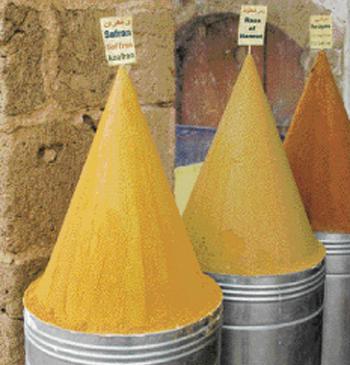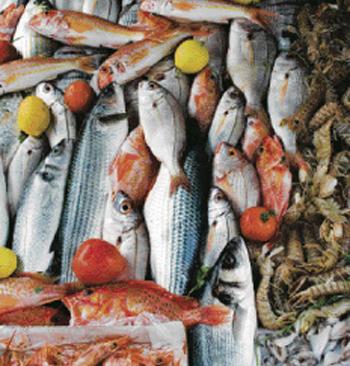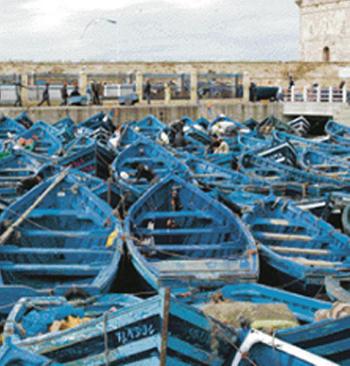From dozens of bright-blue wooden boats tied to the quay, Moroccan sailors heave ashore their catch. I sit watching. It’s my first morning in Morocco after a 27-hour journey from my home on Kaua‘i. I have come to see another
From dozens of bright-blue wooden boats tied to the quay, Moroccan sailors heave ashore their catch. I sit watching. It’s my first morning in Morocco after a 27-hour journey from my home on Kaua‘i. I have come to see another culture, another ocean. Most of all, I have come on a culinary adventure.
I follow a man with a basket of fish and eels. At the old fort wall that surrounds the city, five men squat, working with sharp knives. The man nearest me, who is wearing a metal thumb shield, cuts up eels. Another guts large bass, and so on.
They work quickly, throwing the entrails to the side in a pile. Delighted seagulls squeal and grab a meal.
I stroll toward 15 fish stalls that stretch in an arc along the port overlooking the sea. Each blue and white stall has a box of ice in the front atop which is displayed various bass, flounder, snapper, shellfish and crab. Behind the display are picnic tables that customers share. In the very back is an open air cooking area with a metal trough full of natural charcoal.
Energetic hawkers vie to lure customers. Most call out in French or Arabic, so we are attracted to one shouting to us in English.
“Over here, lady! Best fish! Best price!” he cries.
He helps us pick out tiny squid, some crevettes, a flounder and a bass. The price, including two soft drinks, is about $30. Our fish is taken to the “kitchen” to be cleaned.
The young cook places the squid in a wire basket and sets it directly onto the charcoal. He turns it frequently to keep it from charring. Each course is cooked the same way.
The squid comes first. It is chewy and dense, flavored with the charcoal, smoke and squids’ ink, with a squeeze of lemon. But it doesn’t come close to the magic of the next course. The crevettes are salty, firm and deeply flavored. Their shells are so thin and pleasantly crunchy that we just tear off the legs and heads and eat the rest.
Next the two fish arrive. We de-bone them and feast. The kitchen staff closely watches to see our reaction. Their broad smiles in response to our nods of approval reveal their pride.
Next, a walk through the old medina of Essaouira. Although it has a population of about 50,000 people, it has the feel of a much smaller town inside the ancient fort’s walls. The streets are too narrow for cars (although motorcycles are unfortunately allowed). People, donkeys and carts, cats and more cats — all crowd the stone streets in an endless hubbub from early morning until well after dark. We join the throng moving toward the souks.
We frequently step out of the stream of people to take photos of carved ancient doorways. We are careful to not point our cameras at much else. People object to being photographed, which is understandable, but also scold us if we try to take photos of a pile of oranges, slabs of meat at the butcher or almost anything. I try to take a picture of a beautiful arrangement of fruit at one market stall, but instead I get a good shot of the storekeeper’s hand blocking the photo.
We chance upon a spice shop where the proprietor has mounded some of his spices into a tall cone, using a little paddle and a lot of patience. He is glad to let us take a picture, so we get a little closer to smell the various jars of spice mixtures. He has a pre-mixed concoction for some 30 foods, from fruit salads to kabobs.
At a butcher’s shop, two goats’ heads are prominently displayed. Many of my friends would recoil at the sight, but I think it is important to have a vivid reminder that we carnivores take the lives of other animals. We should be mindful of their sacrifice.
One stall sells dates and nuts, all piled high in boxes. There are dried dates of several types as well as fresh. The seller offers us samples. The dates are sweet and dense, with a chewier texture than dates at home. The almonds are wider and flatter than the ones I am used to from California and have grayish skin that is smoother. There is no bitterness to the skin. We buy a half pound for the equivalent of a dollar.
Amid the spice stalls, we spy some orange boxes full of remedies for whatever ails. One dried herb is “Ramba Zamba” claiming to be a Viagra equivalent. There are also herbal cures for baldness, eczema, migraines and insomnia. As I take a picture, a man passing by barks, “No photo!” He then walks away. It isn’t even his stall.
An afternoon of walking has prepared us for dinner. Because we were so pleased with lunch, we have seafood in mind. We choose Chalet de la Plage overlooking the beach. We sit next to the window and watch the lights of the town reflect against the white tops of the waves. In the light of streetlamps, boys play soccer on the beach.
We start with a dozen small oysters, then order grilled sardines and a grilled sole. Again, the freshness of the seafood, coupled with the smoky taste of real charcoal, is beyond compare. I vow to start barbecuing only with real Kiawe charcoal.
The next day I experience a Moroccan breakfast. The breads and pastries are all made fresh before serving. I am particularly fond of Batbout, a small flat bread made with semolina flour that is light and airy. I also favor the Beghrir, a pancake with a light spongy character that is cooked on only one side. It is superb with melted butter and honey.
After breakfast, it is time to leave Essaouira and move on to Marrakesh. We board a “superbus” for the trip, which takes only a couple of hours. As I gaze at the passing orchards, I reflect upon how vibrant, charming and colorful Essaouria is. Then I recall something the spice seller said: “We in Morocco have a spice for everything.”
• Kathleen Bailey is a food lover and photographer living on Kaua‘i. Visit ponocat.com to read more of her culinary adventures.




